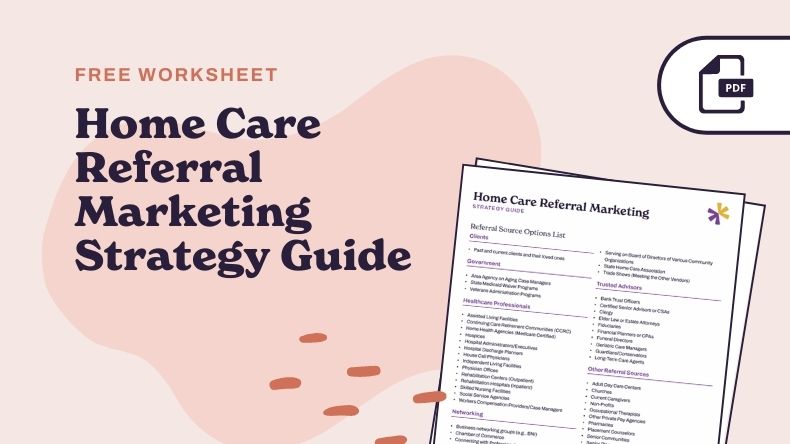Post-acute care organizations should always be looking for ways to grow and nurture their referral sources.
In the post-acute industry, building relationships with referral sources is vital to the very existence of an organization. Whether you are part of a private home care group, a corporately run skilled nursing facility, a home health or hospice agency, or any post-acute space in-between, referrals are how you are able to keep going in the industry. Building solid relationships with your referral sources is a skill that you must possess, or your organization will cease to exist. So how do you build and maintain those strong relationships?
Whether you are a well-established organization or a brand-new entity just breaking into the post-acute space, think about how well you interact with your referral sources. If you could write a book on how to obtain and maintain referral sources, could you do it?
1. Understand the needs and wants of your referral source.
No matter the size or future potential of the referral source, treat them all the same and be consistent. Consider this scenario:
You are the clinical manager of a hospice agency. You get a phone call from a referral source, a local oncology center supplies you with about 18% of all of your referrals. Their social worker calls with four new referrals to begin hospice services. He requests the referrals to all have services started tomorrow and states the families are already in agreement with the plan. You do not have staffing to accommodate the request.
Do you understand this referral source’s needs and wants? Take a deep breath, respect the social worker who must have reasons behind their expressed needs and wants, and dig deeper. Maybe the oncology center is struggling with a high acuity census and fears delayed admissions because of a prior bad experience with another hospice. Ask questions to facilitate your own understanding. See how you may be able to better understand and adapt before immediately making a knee-jerk response. Always put yourself in the position of your referral source, from a large oncology center to a solitary loved one calling to ask questions about a family member who is about to be referred.
2. Make every referral source a part of your team.
Everyone has heard of “there is no ‘I’ in team, right? Your post-acute team is not an “I” either, but rather a small part of many groups in healthcare that work towards maintaining the health and well-being of clients in the post-acute space. Your referral sources are part of that collective, larger team. Respect each other’s contributions and use teamwork to improve outcomes. Consider the following scenario:
You are the Administrator of a skilled nursing facility. You notice lately that the hospital readmission rates are slowly increasing. You call a planning meeting internally with your staff to determine how to improve your outcomes. You feel part of the problem may be a recent influx of unstable discharges from the local hospital that supplies you with a majority of referrals.
Why not include the hospital referral source in your meeting? Consider inviting a few representatives from the hospital to talk about what your entire collective team can do to invest in people receiving healthcare and improve outcomes. Your team is always bigger than you think, invite them and learn from each other.
3. Communicate with referral sources openly and frequently.
Give updates to your referral sources on existing clients and always share positive outcomes in particular. Keep the lines of communication open and honest with all of your referral sources. Consider this scenario:
You are a Clinical Liaison in a home health agency marketing to an assisted living facility (ALF) that you are trying to expand as a referral source. After speaking to the ALF Administrator, you discover they have a complaint about poor communication and delayed receipt of mutual orders and documentation from your agency. You know the assigned case manager is very attentive and are surprised to hear the complaint, but realize this may be why you are not able to build this referral source.
Increase communication efforts immediately. Schedule a routine 15– minute online or in-person meeting for your case manager, yourself, and the ALF representatives to provide each other quick updates. Make communication with your referral sources an easy task and never a chore. Celebrate positive outcomes and talk openly about negative ones to find resolutions.

4. Ask for feedback from your referral sources.
Similar to giving information to your referral sources willingly and routinely to open the lines of communication, always ask for feedback. Discuss what your organization can do to help everyone improve care outcomes. Consider this scenario:
You are an Admissions Director at a new assisted living memory care unit. You opened recently and are looking to grow your resident population. There is a local home health agency that has recommended your facility to a few new residents but otherwise your referrals mostly come from private community members who are curious about the new living arrangement. What do you do to increase your referrals?
Ask for feedback. Call the home health agency and ask what made them recommend your services. Focus on their positive perceptions and accentuate them. Call the individual community members, survey existing family members of residents and ask for their feedback. If the home health agency is impressed by technology in place that is used to keep residents safely monitored, advertise that aspect. If families are impressed by large, comfortable rooms, market that feature. Remember that there is no such thing as bad feedback. Whether positive or negative, it can all be used to your advantage to make changes, focus on best practices, and continue to learn and grow from all feedback.
5. Demonstrate your high-quality care whenever possible.
If you are an accredited organization that has worked hard to maintain high standards of care, don’t forget to tell your community about it. If you have invested in additional training opportunities to grow a particular skillset of your staff, brag about it. Consider this scenario:
You are the Training Manager of a home care agency that has a large population of people diagnosed with dementia symptoms. Your agency has worked hard to provide an additional eight hours annually of dementia-based training to every field staff member in an effort to develop this specialty skill to care for clients with memory problems.
Hang every staff member’s certificate of completion on an office wall, take a picture, post it on social media and brag about your agency’s niche training. Buy a lapel pin from your accrediting body and have every staff member wear it proudly and be able to explain the robust qualification process in the community. Even on a smaller scale, if you have a positive outcome to be proud of, talk about it with your referral sources as proof of your quality of care.
Key Takeaways
So remember, to obtain and maintain your referral sources:
Above all else, think of why you need your referral sources, as well as why they need you, and work together to create the most positive outcomes and deliver the highest quality of care to those in your community. Show that you are invested in obtaining and maintaining your referral sources and keeping that larger team a successful one.







